
TORONTO – There’s an often unrecognized hazard lurking in most Canadian homes that poses a potentially deadly threat to young children – the big-screen TV.
Those top-heavy, flat-screen televisions can topple over onto children, crush their tiny bodies and in the worst-case scenario, fatally cave in their skulls, researchers say.
“The kids who are at the biggest risk are toddlers, so one- to three-year-olds,” said Dr. Michael Cusimano, a neurosurgeon at St. Michael’s Hospital.
“They’re occurring in older kids as well, but these injuries can be extremely severe in the younger kids – and they can be fatal.”
In a review of 29 studies from seven countries published Tuesday in the Journal of Neurosurgery: Pediatrics, Cusimano and co-author Nadine Parker found that tens of thousands of children have been harmed by falling TVs, an occurrence that is becoming increasingly common.
In the U.S., for instance, the Consumer Product Safety Commission reported 19,200 TV-related injuries from 2008 to 2010, up from 16,500 between 2006 and 2008.
The Toronto researchers determined that about 85 per cent of these injuries occurred in the home and more than three-quarters were not witnessed by a parent or caregiver.
“TVs are often placed on unstable bases, placed on high furniture like dressers, which aren’t designed for TVs, or (are) not properly secured to the wall,” said Cusimano.
“Meanwhile, parents are getting busier and busier and don’t have as much time to supervise children, so it’s not surprising that these injuries are getting reported more often.”
He said accidents often happen when toddlers climb up on a piece of furniture that holds the TV. Somewhat older children may run into the furniture while horsing around and cause the television to fall on them.
“They’re not being secured properly, they’re not being used on the proper furniture,” Cusimano said of big-screen TVs, which have become increasingly larger and less expensive over time.
“I heard of one case where (the family) had it on top of an aquarium, and the TV came down and crushed the child,” he said. “The child died.”
A 2005 study led by pediatric neurosurgeon Dr. James Drake at the Hospital for Sick Children in Toronto showed 18 children, aged 12 months to 10 years old, had been treated for a range of injuries due to falling TVs between 1992 and 2005. Sixteen of them had skull fractures.
Some of the children were left with short- and long-term symptoms, from neurological deficits causing severe disability to hearing loss and facial paralysis.
One two-year-old, who was treated at Sick Kids following submission of the study to the Journal of Neurosurgery: Pediatrics, died after an 81-centimetre (32-inch) TV fell off its stand and fractured the child’s skull.
“It’s often like a crush injury,” Drake said in an interview Monday. “So it’s not what we would call a high-velocity head injury like you would have in a car accident. This is relatively low-velocity, but the TVs are very heavy, so they sort of crush the skull.”
“So that causes these fractures and often injures the nerves at the base of the skull that control the face and the eyes and the hearing. Many recover, but some of them are left with a permanent deficit.”
According to the Canadian Hospitals Injury Reporting and Prevention Program (CHIRPP), Sick Kids treated 33 children who had been injured by falling TVs between 2011 and 2013. Twelve of the children were admitted, 16 had head injuries and 18 had fractures, including skull fractures.
For privacy reasons, the hospital does not reveal the number of deaths, but a spokeswoman said there were “under five.”
“It’s a totally preventable trauma,” agreed Drake,” and families need to be vigilant and tether their TVs so they can’t possibly fall over. And children watching TV do need to be monitored.”
Cusimano said parents, grandparents and other caregivers can take steps to prevent this needless injury:
*Avoid placing toys or remotes on top of the TV.
*Create a restricted play area around the television.
*Use a proper TV stand or console; don’t place it on top of a high piece of furniture.
*Position the TV back from the edge of where it’s placed.
*Attach the TV to the wall to prevent it from falling.